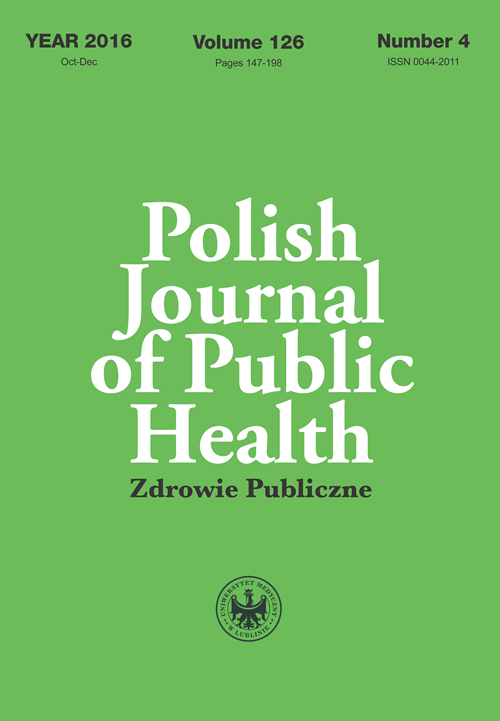Sociomedical and epidemiological analysis of patients aged 18-34 years visiting the dental office
DOI:
https://doi.org/10.1515/pjph-2016-0038Keywords:
oral health, adults, DMF index, dental visit, PolandAbstract
Introduction. Carelessness in caring for oral cavity in adults may contribute to severity of dental caries, periodontal diseases and diseases of mucous membranes that pose a risk to health of both dental and systemic character.
Aim. The aim of the study was to assess the relationship between selected demographic factors and the cause of visiting the dental practitioner and the dental health status in adults.
Material and methods. The study comprised 194 patients, aged 18-34 who visited in 2015 one of the dental offices in Lublin, which offers treatment under the framework of an agreement with the National Health Fund or for a fee. Gender, age, the place of residence and the reason for visiting the dental office were analyzed. The place of residence was a village, a town of less than 200 thousand inhabitants or the city of more than 200 thousand inhabitants. The reason for visiting the dental office was a checkup visit, loss of filling or a toothache. Dental condition was assessed by calculating the DMF index. The results were statistically analyzed.
Results. In the group of respondents, women accounted for 53.62%, and men – 45.88%. The prevalence of dental caries was 100% and the incidence expressed by the mean DMF index was 14.64±5.78, and increased with age. The main reason for visiting the dentist for 65.46% of respondents was a check-up visit, for 17.53% – loss of filling and for 17.01% – a toothache. The lowest incidence of tooth decay was found in people visiting the dentist for a check-up, higher in patients appearing with the loss of filling and toothache.
Conclusions. A high percentage of people visiting the dentist because of toothache, confirms the low level of health-related knowledge in adult patients. High incidence of tooth decay proves the need to intensify preventive measures against the carious disease in adults. It is necessary to intensify educational activities and programs addressed to the adult part of Polish society to prevent the development of dental caries.
References
1. Borysewicz-Lewicka M, Wochna-Sobańska M. Stomatologiczne zachowania prozdrowotne ludności Polski w świetle badań epidemiologicznych wykonanych w roku 2003 w ramach programu „Miesiąc totalnie zdrowego uśmiechu”. Czas Stomatol. 2007;60:377-83.
2. Nowakowska-Socha J. Stomatologiczne leczenie estetyczne w obecnych warunkach socjoekonomicznych oraz jego wpływ na higienę i samoocenę u leczonych pacjentów na podstawie badań ankietowych i klinicznych. Roczniki Pomorskiej Akademii Medycznej w Szczecinie. 2007;53:100-13.
3. Michalak E, Łoboda J, Chomyszyn-Gajewska M. Przyczyny zgłaszania się pacjentów do krakowskich gabinetów stomatologicznych w latach 2005-2006 i 2013-2014. Przegl Epidemiol. 2015;69:913-8.
4. Monitorowanie stanu zdrowia jamy ustnej populacji polskiej w latach 2013-2015. Minister Zdrowia, Program na lata 2013-2015. [http://www2.mz.gov.pl/wwwfiles/ma_struktura/docs/monitjamyust_progr2013_20130510.pdf 14.10.2016.]
5. Wochna-Sobańska M, Lubowiedzka-Gontarek B, Szydłowska-Walendowska B, Proc P. Wpływ higieny jamy ustnej na intensywność próchnicy u osób dorosłych mieszkających od urodzenia na terenie z ponadoptymalną zawartością fluoru w wodzie pitnej. Czas Stomatol. 2008;61:323-9.
6. Pytko-Polończyk J, Loster B. W. Lecznicze potrzeby stomatologiczne pacjentów zgłaszających się do Uniwersyteckiej Kliniki Stomatologicznej w Krakowie w roku 2008. Implantoprotetyka. 2009;10:48-51.
7. Ziętek M. Zdrowie jamy ustnej Polaków. Czas Stomatol. 2005;58:388-91.
8. Hilt A, Rybarczyk-Townsend E, Lubowiedzka-Gontarek B, Wochna-Sobańska M. Problemy zdrowotne jamy ustnej 35-44-letnich mieszkańców województwa łódzkiego. Przegl Epidemiol. 2012;66:133-8.
9. Ganowicz M, Pierzynowska E, Zawadziński M, et al. Ocena stanu uzębienia i stomatologicznych potrzeb leczniczych młodzieży w wieku 18 lat w Polsce w 2004 roku. Nowa Stomatol. 2006;1:27-33.
10. Strużycka I, Małkowska A, Stopa J. Efektywne sposoby promocji zdrowia jamy ustnej. Czas Stomatol. 2005;58:392-6.
11. Strużycka I, Wierzbicka M, Jodkowska E, et al. Wyniki Monitoringu Stanu Zdrowia Jamy Ustnej populacji młodych dorosłych w Polsce w 2012 roku. Nowa Stomatol. 2013;4:195-9.
Downloads
Published
Issue
Section
License
Copyright (c) 2017 Polish Journal of Public Health

This work is licensed under a Creative Commons Attribution-NonCommercial-NoDerivatives 3.0 Unported License.


